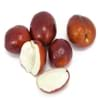Health Benefits
Cancer prevention, Diarrhea treatment, Improves muscular strength, Liver health, Maintains hormonal balance, Reduces nervous tension, Reduces blood circulation problems, Reduces stress, Regulation of heart rate, Treatment of hysteria
Increases metabolic rate, Lower blood pressure, Protects against kidney stone formation
General Benefits
Anti oxidant properties, Digestive aid, Flu treatment, Helps in weight loss, Strengthens bones, Treatment of common cold
Gives you energy
Skin Benefits
Heals sunburn, Hydrates skin, Reduces wrinkles, Skin rejuvenation, Skin revitalization
Skin cleansing
Hair Benefits
Promotes longer and healthier hair, Protects hair
NA
Allergy Symptoms
Abdominal pains, Breathing difficulty, Diarrhea, Hives, Itching in eyes, Itching of nose, Nasal congestion, Redness of eyes, Runny nose, Sneezing, Wheezing
NA
Side Effects
Decrease in blood sugar levels, Intense headache
Affects blood glucose levels, Decrease in blood sugar levels, Coagulation
Lactating Women
Not Available
No
Best Time to Eat
As a snack in the late afternoon, Don't consume at night and before bed, Morning time (before lunch), Strictly avoid empty stomach
As a snack in the late afternoon, Eat the fresh ones, avoid mixing with any other foods, don't eat after meal., Morning time (before lunch)
Vitamin A (Retinol)
Not Available
Vitamin B1 (Thiamin)
Not Available
Vitamin B2 (Riboflavin)
Not Available
Vitamin B3 (Niacin)
Not Available
Vitamin B6 (Pyridoxin)
Not Available
Vitamin C (Ascorbic Acid)
Water Content
Not Available
Calories in Fresh Fruit with Peel
Calories in Fresh Fruit without Peel
Not Available
Not Available
Calories in Frozen Form
Not Available
Not Available
Calories in Dried Form
Not Available
Calories in Canned Form
Not Available
Not Available
Calories in Juice
Not Available
Calories in Jam
Not Available
Season
Autumn, Summer
Dry
Varieties
Honey Jar, Sugar Cane, Li, Shanxi Li, Sherwood, Chico, Silverhill, Tigertooth, Winter Delight and Lang
NA
Color
Green, Red, Yellow
Orange, Yellow
Inside Color
White
Creamy Yellow
Texture
Crunchy
Succulent
Soil Type
Sandy, Well-drained
Loamy
Climatic Conditions
Warm to hot climate
Warm
Facts about
- Pigment extracted from Indian jujube is used for silk dyeing in Burma.
- In Korea, jujube wood is used to make wind instrument taepyeongso.
- Fresh jujube is known as Chinese apple & dried form is called as Chinese date.
- The name is derived from the word "ugly" refering to the it's unpleasant appearance, with rough, wrinkled, greenish-yellow rind, wrapped loosely around the orange pulpy citrus inside.
Top Producer
China
Jamaica
Other Countries
Bangladesh, India, Iran, Korea, Lebanon, Pakistan
NA, United States of America
Top Importer
United States of America
Europe
Top Exporter
China
Jamaica
Botanical Name
Ziziphus zizyphus
Citrus reticulata × Citrus paradisi
Synonym
Ziziphus jujuba or Ziziphus mauritania or Zizyphus jujuba
Tangelo, citrus tangelo
Subkingdom
Tracheobionta
Tracheobionta
Division
Magnoliophyta
NA
Class
Magnoliopsida
Unknown
Family
Rhamnaceae
Rutaceae
Species
Z. zizyphus
C. reticulata × paradisi
Generic Group
Not Available
Citrus fruit
Difference Between Jujube and Ugli fruit
We might think that Jujube and Ugli fruit are similar with respect to nutritional value and health benefits. But the nutrient content of both fruits is different. Jujube and Ugli fruit Facts such as their taste, shape, color, and size are also distinct. The difference between Jujube and Ugli fruit is explained here.
The amount of calories in 100 gm of fresh Jujube and Ugli fruit with peel is 79.00 kcal and 45.00 kcal and the amount of calories without peel is Not Available and Not Available respectively. Thus, Jujube and Ugli fruit belong to and category.These fruits might or might not differ with respect to their scientific classification. The order of Jujube and Ugli fruit is Rosales and Sapindales respectively. Jujube belongs to Rhamnaceae family and Ugli fruit belongs to Rutaceae family. Jujube belongs to Ziziphus genus of Z. zizyphus species and Ugli fruit belongs to Citrus genus of C. reticulata × paradisi species. Beings plants, both fruits belong to Plantae Kingdom.









